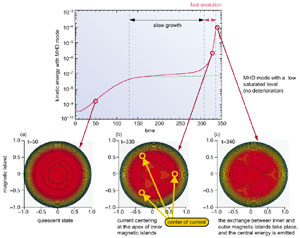Plasma disruptions (the phenomena terminating stable plasma discharges) are derived from magnetohydrodynamic(MHD) activities. MHD activities ordinarily appear as minute oscillations in plasmas. There are two cases with MHD activities; (1) MHD activities which do not grow, or, (2) MHD activities which grow with time and then their amplitudes become so large that the activities deform plasma columns. There is some possibility that MHD activities will evolve to a plasma disruption in the latter case (2). It is therefore important to explain the growth of MHD activities in order to investigate plasma disruptions.
Considering that the irregularity of magnetic structures inside plasmas (the width of a magnetic island) is a key factor for the growth of MHD activity evolving to a plasma disruption, we have performed numerical simulations on inner magnetic structures. Figure 3-12 shows the time evolution of magnetic structures for the plasma with a hollow profile of plasma current. The time and the kinetic energy of the MHD mode in the figure are respectively normalized to their characteristic quantities. During early and intermediate periods the MHD mode is stable, and magnetic islands are growing very slowly. The mode moves to be suddenly unstable when the widths of magnetic islands become so large that two groups of magnetic islands evolve to one group of magnetic island with its large island-width. The reason for this movement is that, as shown in Fig. 3-12 (b) and (c), the triangular distortion of the inner magnetic islands is generated by the evolution of the MHD mode and that the distortion destroys the outer cylindrical magnetic structure. |

